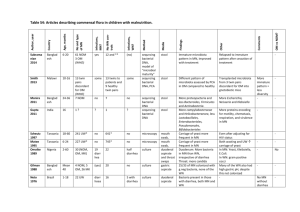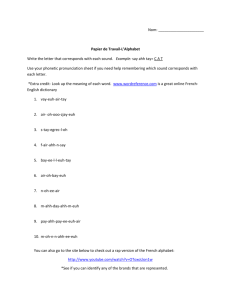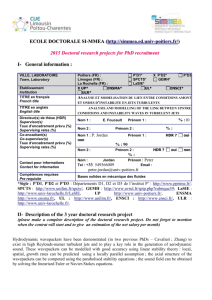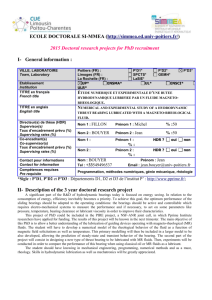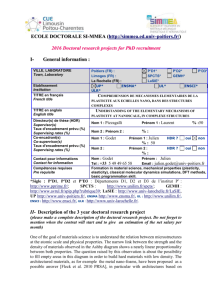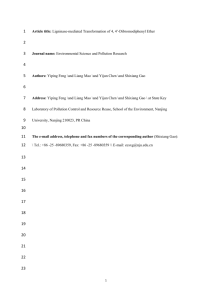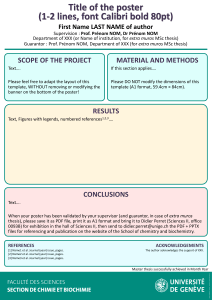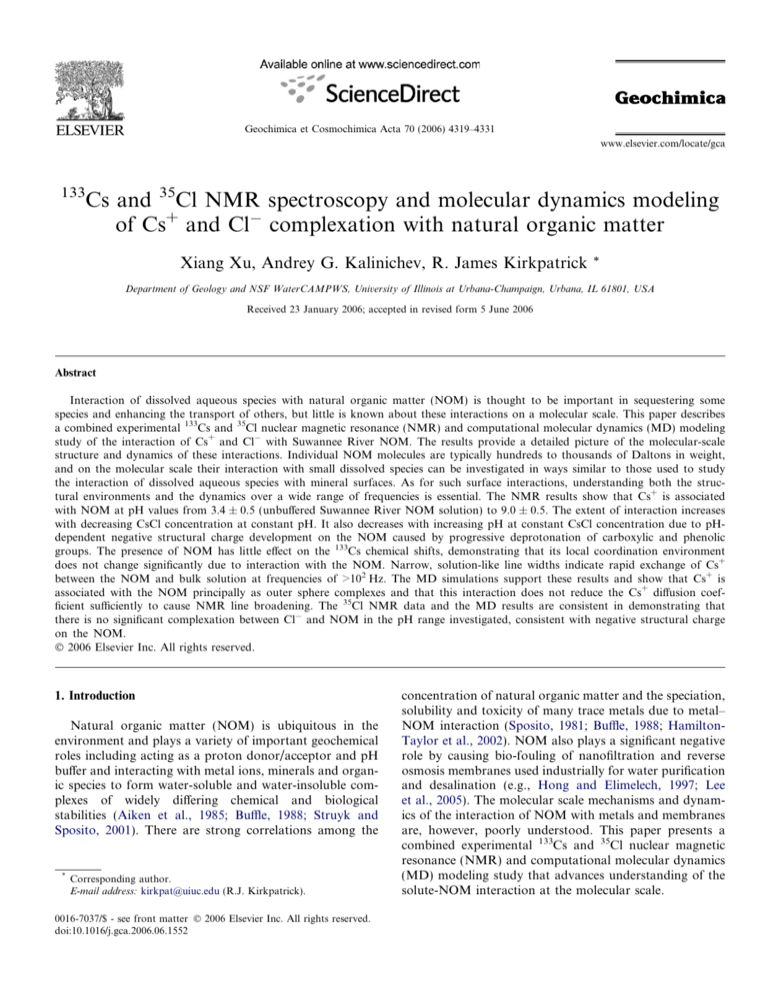
Geochimica et Cosmochimica Acta 70 (2006) 4319–4331
www.elsevier.com/locate/gca
133
Cs and 35Cl NMR spectroscopy and molecular dynamics modeling
of Cs+ and Cl complexation with natural organic matter
Xiang Xu, Andrey G. Kalinichev, R. James Kirkpatrick
*
Department of Geology and NSF WaterCAMPWS, University of Illinois at Urbana-Champaign, Urbana, IL 61801, USA
Received 23 January 2006; accepted in revised form 5 June 2006
Abstract
Interaction of dissolved aqueous species with natural organic matter (NOM) is thought to be important in sequestering some
species and enhancing the transport of others, but little is known about these interactions on a molecular scale. This paper describes
a combined experimental 133Cs and 35Cl nuclear magnetic resonance (NMR) and computational molecular dynamics (MD) modeling
study of the interaction of Cs+ and Cl with Suwannee River NOM. The results provide a detailed picture of the molecular-scale
structure and dynamics of these interactions. Individual NOM molecules are typically hundreds to thousands of Daltons in weight,
and on the molecular scale their interaction with small dissolved species can be investigated in ways similar to those used to study
the interaction of dissolved aqueous species with mineral surfaces. As for such surface interactions, understanding both the structural environments and the dynamics over a wide range of frequencies is essential. The NMR results show that Cs+ is associated
with NOM at pH values from 3.4 ± 0.5 (unbuffered Suwannee River NOM solution) to 9.0 ± 0.5. The extent of interaction increases
with decreasing CsCl concentration at constant pH. It also decreases with increasing pH at constant CsCl concentration due to pHdependent negative structural charge development on the NOM caused by progressive deprotonation of carboxylic and phenolic
groups. The presence of NOM has little effect on the 133Cs chemical shifts, demonstrating that its local coordination environment
does not change significantly due to interaction with the NOM. Narrow, solution-like line widths indicate rapid exchange of Cs+
between the NOM and bulk solution at frequencies of >102 Hz. The MD simulations support these results and show that Cs+ is
associated with the NOM principally as outer sphere complexes and that this interaction does not reduce the Cs+ diffusion coefficient sufficiently to cause NMR line broadening. The 35Cl NMR data and the MD results are consistent in demonstrating that
there is no significant complexation between Cl and NOM in the pH range investigated, consistent with negative structural charge
on the NOM.
2006 Elsevier Inc. All rights reserved.
1. Introduction
Natural organic matter (NOM) is ubiquitous in the
environment and plays a variety of important geochemical
roles including acting as a proton donor/acceptor and pH
buffer and interacting with metal ions, minerals and organic species to form water-soluble and water-insoluble complexes of widely differing chemical and biological
stabilities (Aiken et al., 1985; Buffle, 1988; Struyk and
Sposito, 2001). There are strong correlations among the
*
Corresponding author.
E-mail address: kirkpat@uiuc.edu (R.J. Kirkpatrick).
0016-7037/$ - see front matter 2006 Elsevier Inc. All rights reserved.
doi:10.1016/j.gca.2006.06.1552
concentration of natural organic matter and the speciation,
solubility and toxicity of many trace metals due to metal–
NOM interaction (Sposito, 1981; Buffle, 1988; HamiltonTaylor et al., 2002). NOM also plays a significant negative
role by causing bio-fouling of nanofiltration and reverse
osmosis membranes used industrially for water purification
and desalination (e.g., Hong and Elimelech, 1997; Lee
et al., 2005). The molecular scale mechanisms and dynamics of the interaction of NOM with metals and membranes
are, however, poorly understood. This paper presents a
combined experimental 133Cs and 35Cl nuclear magnetic
resonance (NMR) and computational molecular dynamics
(MD) modeling study that advances understanding of the
solute-NOM interaction at the molecular scale.
4320
X. Xu et al. 70 (2006) 4319–4331
NOM is compositionally and structurally complex and
heterogeneous, and NOM samples from different locations
often have significantly different structures and compositions. It is normally not possible to define a unique structure, even for NOM from one locality. The reported
apparent molecular weights range from a few hundred to
several hundred thousand Daltons (e.g., Perminova et al.,
2003). Whether NOM molecules are single macromolecular
entities or supramolecular assemblages of smaller molecules held together by relatively weak attractive forces is
still under discussion (Swift, 1999; Wershaw, 1999; Haynes
and Clapp, 2001; Piccolo, 2001; Leenheer and Croué,
2003). The most recent experimental evidence seems to support the latter view (Simpson et al., 2002; Peña-Méndez
et al., 2005). These uncertainties contribute to the difficulty
in characterizing metal–NOM binding in molecular-scale
detail. It is known that the extent of binding varies with
the size, composition and configuration of the NOM, the
pH and the ionic strength of the solution, the chemical
properties of the metal, and the metal/NOM compositional
ratio (Buffle, 1988; Li et al., 1998; Myneni et al., 1999; Elkins and Nelson, 2002; Huber et al., 2002; Tipping et al.,
2002; Pullin and Cabaniss, 2003; Ritchie and Perdue,
2003). Previous sorption studies of metal–NOM binding
have provided important, quantitative potentiometric titration data and ion absorption isotherms (Sposito, 1981; Oliver et al., 1983; Buffle, 1988; Gaffney et al., 1996; Leenheer
et al., 1998; Li et al., 1998; Davies et al., 2001; Elkins and
Nelson, 2002; Hamilton-Taylor et al., 2002; Tipping et al.,
2002; Ritchie and Perdue, 2003). These experiments, however, do not directly probe molecular scale interactions
and, thus, do not provide information about the structure,
dynamics, and chemical mechanisms of interaction. 13C
and 1H NMR and FT-IR spectroscopic studies of Ca2+-,
Cd2+-, Cu2+-, Ni2+-, and Zn2+-exchanged fulvic acid
(FA) isolated from Suwannee River NOM, however, have
suggested that metals are bound to FA in different ways
(Leenheer et al., 1998). The results suggest, for instance,
that Ca2+ is coordinated to the FA carboxylic groups as inner sphere complexes, whereas Cd2+ occurs as outer sphere
complexes associated with the quinone carbonyl groups.
13
C, 1H, and 1H–13C CP/MAS NMR are also commonly
used to probe NOM structure and provide important
quantitative information about the carbon content and
functional groups (Mao et al., 2000; Wershaw et al.,
2000; Conte et al., 2002; Kaiser, 2003; Ritchie and Perdue,
2003).
There have been fewer studies of NOM behavior using
the NMR properties of the solute species. 113Cd NMR
chemical shifts combined with titration data show that
Cd2+ complexation with Suwannee River NOM occurs primarily with carboxylic groups at Cd/C ratios of 0.001–
0.007 and pH 3–9. The 113Cd2+ peak widths increase with
increasing pH, suggesting that the Cd–NOM exchange
rates are higher at acidic conditions than at higher pHs
(Li et al., 1998). For 51V, the NMR chemical shifts vary significantly with pH and concentration, indicating interac-
tion of a variety of vanadate and poly-vanadate ions with
aquatic humic substances (Lu et al., 1998).
Similarly, despite decades of widespread use of computational molecular dynamics (MD) and Monte Carlo
(MC) methods (e.g., Allen and Tildesley, 1987; Cygan
and Kubicki, 2001; Schlick, 2002), these techniques have
been rarely applied to the investigation of NOM and its
interaction with aqueous solutions and mineral surfaces
(Schulten and Schnitzer, 1997; Leenheer et al., 1998; Kubicki and Apitz, 1999; Sein et al., 1999; Shevchenko et al.,
1999; Diallo et al., 2003; Porquet et al., 2003; Sutton
et al., 2005). Classical molecular computer simulations
are typically performed for systems containing 103–106 particles (atoms, ions, and/or molecules) and can thus effectively capture longer range and cooperative behavior of
the simulated systems. Using standard statistical mechanics
formalism to analyze the large number of computed instantaneous molecular configurations (e.g., Allen and Tildesley,
1987), these methods can yield many important thermodynamic, structural, spectroscopic, and transport properties.
Molecular modeling of NOM is complicated by the lack
of well-defined compositions and structures for the NOM
molecules (e.g., Sein et al., 1999; Diallo et al., 2003; Leenheer and Croué, 2003). Nevertheless, the principal functional
groups of many NOMs are known (Ritchie and Perdue,
2003), and previously proposed structural models for
NOM molecules (Sein et al., 1999) allow for their effective
MD modeling.
This paper describes a combined NMR and MD study
of the interaction of Cs+ and Cl with NOM in aqueous
solution. The results show that the ability of combined
NMR and MD studies to effectively probe molecular-scale
structure and dynamics at solution–solid interfaces (Weiss
et al., 1990; Kim et al., 1996b; Kim and Kirkpatrick,
1997, 1998; Yu and Kirkpatrick, 2001; Rossi et al., 2003)
can be extended to NOM in solution. Experimentally,
133
Cs and 35Cl NMR chemical shift, line width, and 1/T1
relaxation rate data for solutions containing Cs+, Cl,
and Suwannee River NOM (SRNOM) were obtained to
explore both the structural and dynamical aspects of the
interactions. SRNOM was chosen for the study, because
its composition is relatively well characterized (Aiken
et al., 1994; Wagoner and Christman, 1997). 137Cs is an
important and abundant component of many nuclear
waste streams. It is one of the most hazardous radionuclides in the environment because of its high mobility,
strong c-emission, relatively long half-life (t1/2 = 30.17
years), and high solubility (Walling and Quine, 1991;
Ruhm et al., 1999; Bunzl et al., 2001; Hinton et al.,
2001). Previous research has shown a strong and direct effect of organic matter on Cs fixation (Tegen et al., 1991;
Thiry and Myttenaere, 1993; Valcke and Cremers, 1994),
but the mechanisms are unknown. From an NMR perspective, 133Cs is readily observed with relatively high sensitivity. It has a 100% natural abundance and a small electric
quadrupolar moment (Q = 3 · 1031 m2), resulting in
quite narrow solid state line widths. Previous 133Cs NMR
NMR Spectroscopy and MD Modeling of Cs+ and Cl Complexation with NOM
studies of Cs+ adsorption onto clay minerals including
kaolinite and illite have shown that NMR is an effective
tool to investigate its adsorption sites and atomic-scale
dynamics on mineral surfaces (Weiss et al., 1990; Kim
et al., 1996a,b; Kim and Kirkpatrick, 1997, 1998). The results have shown that Cs+ is adsorbed on mineral surfaces
both by direct coordination to the surface (inner sphere
complexes) and more loosely as outer sphere complexes
and in the diffuse layer. 35Cl NMR has also been shown
to be an effective probe of the structure and dynamics of
surface-associated Cl (Kirkpatrick et al., 1999; Yu and
Kirkpatrick, 2001).
2. Methods
2.1. Materials and sample preparation
The SRNOM was purchased from the International Humic Substances Society (Cat. No. 1R101N). It was originally collected from the Suwannee River in Georgia, USA,
and was purified using reverse osmosis (Ritchie and Perdue, 2003). Its elemental composition (wt %) is C 52.47%,
H 4.19%, O 42.69%, N 1.10%, S 0.65%, and P 0.02%
(Ritchie and Perdue, 2003). The major acid sites estimated
from titration data are carboxylic groups: 9.85 mol/kgC
and phenolic groups: 3.94 mol/kgC (Ritchie and Perdue,
2003).
NMR data were collected for two sets of CsCl–NOM
solution samples. The objective of sample set I was to evaluate the concentration dependence of Cs+ and Cl complexation with SRNOM at the natural pH of our NOM
solution near 3.4. These solutions were prepared by first
dissolving the NOM in MilliQ water at a fixed concentration of 0.6 mg/ml and then adding the desired amount of
solid CsCl to 2 ml of the 0.6 mg/ml NOM solution in a
10 mm glass NMR tube. After the CsCl dissolved, MilliQ
water was added to make a total solution volume of
3 ml. The NOM/CsCl ratios were, thus, controlled by varying the CsCl concentrations from 0.0001 to 4 M at a fixed
NOM concentration of 0.4 mg/ml. No background electrolyte was used. The pH values of these CsCl–NOM mixtures
were all 3.4 ± 0.5. Reference neat CsCl solutions were also
made with concentrations ranging from 0.0001 to 4 M. The
pH values of these samples were all 7.0 ± 0.5. The objective
of sample set II was to investigate the effect of pH on Cs+
and Cl association with NOM. Samples were prepared
using the methods described above. HCl and CsOH were
then added to adjust the pHs of the CsCl–NOM and neat
CsCl solutions to values of 3.4 ± 0.5, 7.0 ± 0.5, and
9.0 ± 0.5, with Cs+ concentrations varying from 0.001 to
1 M.
2.2.
133
Cs and
35
Cl NMR measurements
The 133Cs and 35Cl NMR data for sample set I were collected with a Varian UNITY INOVA 500WB NMR
spectrometer and the data for sample set II with a Varian
4321
UNITY INOVA 600WB NMR spectrometer. Both systems were controlled by a SUN SPARCstation 5 computer
via a Varian VNMR software overlay. In all cases, freshly
prepared samples were held in 10 mm NMR tubes at a
fixed temperature of 22 C and were examined without
probe spinning. A phase cycled, single pulse sequence
was used to obtain 133Cs and 35Cl chemical shifts. Typical
parameters for 133Cs were: spectral width 70 ppm, pulse
width 14.4–22.9 ls (90 pulse angle), and recycle time
60 s. For 35Cl these were: spectral width 70 ppm, pulse
width 15.5–22.1 ls (90 pulse angle), and recycle time
0.3 s. A standard inversion-recovery pulse sequence
(180–s–90-acquire) was used for T1 measurements.
Depending on CsCl concentration, between 2 and 516
scans were collected for both nuclei. A 10 Hz line broadening was performed on the free induction decays before
Fourier transformation. All the chemical shifts were externally referenced to a 1 M CsCl solution standard, which
was assigned to 0 ppm for both 133Cs and 35Cl. The chemical shift of D2O used for the deuterium frequency lock was
used as a secondary reference. Several CsCl–NOM samples
at pH 3.4 ± 0.5 and neat solutions at pH 7.0 ± 0.5 from
sample set I were examined using both the 500WB and
600WB NMR spectrometers. In all cases, the chemical
shifts and T1 values at the two fields are identical to within
experimental error and it is, thus, acceptable to compare
data from the two instruments.
2.3. Molecular modeling methods
The ‘‘Steelink’’ and ‘‘Temple-Northeastern-Birmingham’’ (TNB) models of humic acid monomers (Sein
et al., 1999) were used in our simulations. Preliminary
MD simulations for NOM–CsCl aqueous solutions were
performed for both models, but most of the production
MD runs used the TNB model, because its C/O/H ratio
corresponds slightly better to that of SRNOM (Table 1).
Both models have 3 carboxylic groups, 3 carbonyl groups,
2 phenolic groups, and 4 other R–OH alcohol groups. The
TNB model also has 2 amine groups, while the Steelink
model has only one. The molecular weight of the TNB
model is 753 Daltons, which is within the range of the most
frequently occurring NOM molecules (Simpson et al.,
2002; Peña-Méndez et al., 2005).
For the simulations, we assume that the carboxylic
groups of NOM are fully deprotonated and the phenolic
groups are fully protonated, thus simulating near-neutral
pH conditions. The 3 charge of the resulting NOM anion
was compensated by adding 3 initial Cs+ ions, and this system was hydrated by 556 water molecules in a cubic MD
simulation box with periodic boundary conditions (e.g., Allen and Tildesley, 1987; Schlick, 2002). More concentrated
NOM–CsCl solutions were created by randomly substituting Cs+ and Cl for some of the H2O molecules. Neat CsCl
aqueous solutions of the same concentrations were simulated for comparison. A total of 16 MD simulations were performed covering the concentration range from 0.1 to 4.0 M
4322
X. Xu et al. 70 (2006) 4319–4331
Table 1
Compositions of NOM building blocks according to the two models used in the MD simulations
a
Steelink
TNBa
Exp. (SR)b
a
b
C (wt %)
H (wt %)
O (wt %)
N (wt %)
S (wt %)
P (wt %)
Carboxyl (mol/kgC)
Phenolic (mol/kgC)
59.5
57.4
52.5
5.2
4.9
4.2
33.5
34.0
42.7
1.8
3.7
1.1
—
—
0.6
—
—
0.02
6.6
7.0
9.85
4.4
4.5
3.94
Sein et al. (1999).
Experimental data for Suwannee River NOM (Ritchie and Perdue, 2003).
for both neat and NOM containing solutions. Fig. 1 illustrates the size and composition of the simulated systems.
The widely used simple point charge (SPC) potential
(Berendsen et al., 1981) was applied in our simulations to
describe the intermolecular interactions of water molecules.
The SPC-compatible parameters for Cs+–H2O and Cl–
H2O interactions were taken from the literature (Dang
and Smith, 1993; Dang, 1995). The interactions of NOM
molecules with aqueous species were described using the
consistent valence force field (CVFF; Kitson and Hagler,
1988), which is also consistent with the SPC water model.
Long-range electrostatic contributions to the intermolecular potential energy in the simulated systems were calculat-
ed using an Ewald summation algorithm, and a ‘‘spline
cutoff’’ method was applied to the short-range van der
Waals interactions (e.g., Allen and Tildesley, 1987). The
MD time step was 1.0 fs. To assure proper thermodynamic
equilibration and NOM conformational relaxation of the
initial models, pre-equilibration MD runs were performed
for all simulated systems in several stages. First, a constant-volume (NVT-ensemble) MD simulation was run
for 20 ps at a high temperature of 600 K. Then the temperature was decreased in 50 K steps with similar MD equilibration at each step until the system was brought to 300 K.
At this temperature an additional 20 ps pre-equilibration
MD run was performed at a constant pressure of 1 bar
Fig. 1. A snapshot of the MD simulation box containing the NOM model (Sein et al., 1999) in 0.3 M Cs+ aqueous solution. Carbon atoms of NOM are
colored light brown, oxygen atoms are red, hydrogen atoms are gray, nitrogen atoms are blue, and green balls are Cs+ ions in the outer-sphere
coordination to NOM carboxylic groups (left and right) and in the bulk aqueous solution (back, middle). Some water molecules are removed for clarity.
NMR Spectroscopy and MD Modeling of Cs+ and Cl Complexation with NOM
using the standard NPT-ensemble MD algorithm (e.g.,
Allen and Tildesley, 1987). These optimized models were
used as the starting configurations for the production
MD simulation runs which were all performed in the
NVT-ensemble at 300 K. Each system was allowed to
equilibrate for an additional 20 ps before its equilibrium
dynamic trajectory was recorded over the final 100 ps of
MD simulation at 10 fs intervals for statistical analysis.
For the neat aqueous CsCl solutions, the volume of the
MD simulation box at each concentration was initially
adjusted to reproduce the experimentally known solution
densities under ambient conditions (Lide, 2004). In these
simulations, a 50 ps pre-equilibration preceded each
100 ps production run of NVT-ensemble MD simulation.
To assess the effects of NOM on the structural environments, diffusion, and vibrational behavior of Cs+, we calculated the radial distribution functions (RDFs), running
coordination numbers, diffusion coefficients, and power
spectra of molecular motions in the solution using standard
procedures (e.g., Allen and Tildesley, 1987). The running
coordination numbers, nij(r), were calculated from the
RDFs as
Z rmax
nij ðrÞ ¼ 4pqj
gij ðrÞr2 dr;
ð1Þ
0
where the index i corresponds to Cs+ ions, index j to all other
species in solution to which Cs+ can coordinate, qj is the
number density of species j in the system, rmax is the cutoff
radius defining the size of the coordination shell, and gij(r)
are the atom–atom RDFs. Based on the computed positions
of the Cs+ RDF minima, we define the radii of the first and
second coordination shells around Cs+ as rImax ¼ 3:9Å and
rIImax ¼ 6:8Å. The diffusion coefficients of all species were calculated from their mean-square displacements. The power
spectra of low-frequency dynamics of Cs+ and other solution
species were calculated as Fourier transforms of the corresponding atomic velocity autocorrelation functions, in a
manner similar to the one we used earlier to calculate the
vibrational spectra of interlayer and surface species of layered double hydroxides (Kalinichev and Kirkpatrick, 2002;
Wang et al., 2003; Kirkpatrick et al., 2005).
3. Results and interpretation
3.1. 133Cs and 35Cl NMR T1 data and spectral
characteristics
The 133Cs 1/T1 relaxation rates of CsCl–NOM mixtures
increase dramatically with decreasing [Cs]/[NOM] ratio,
but are essentially constant for the neat CsCl solutions at
all pH values (Fig. 2). For the CsCl–NOM mixtures, the
1/T1 values increase with increasing pH at constant [Cs]
and increase with decreasing [Cs] at constant pH. At [Cs]
greater than about 1 M, they all converge to a value of
0.082 Hz, which is essentially identical to the value for neat
solutions (0.084 Hz). At pH 3.4 ± 0.5, maximum observed
1/T1 is approximately three times larger at low concentra-
4323
Fig. 2. 133Cs 1/T1 relaxation rates of CsCl–NOM mixtures at
pH = 3.4 ± 0.5, 7.0 ± 0.5, and 9.0 ± 0.5 increase with decreasing [Cs]/
[NOM] ratio, whereas they remain essentially constant for neat CsCl
solutions. Data for the neat solutions at all pH values plot on top of each
other in this diagram.
tions ([Cs] = 0.0001 M) than at high concentrations
([Cs] = 4 M), and at pH 7.0 ± 0.5 and 9.0 ± 0.5, the largest
values (2.921 and 2.560 Hz, respectively) are about 30 times
larger than at high concentrations. The 1/T1 values for the
CsCl–NOM mixtures do not converge to a constant value
at low [Cs].
The 133Cs full-widths at half-height (FWHH) of the
CsCl–NOM mixtures parallel the 1/T1 relaxation rates,
decreasing with increasing [Cs] from a maximum of about
20 Hz at low [Cs] to 10 Hz at high concentrations (data not
shown). For the neat solutions they are essentially constant
at about 10 Hz. There is no significant or systematic variation in the total 133Cs NMR signal intensity with varying
[Cs]. This contrasts with the situation for vanadate–
NOM interaction, for which quadrupolar line broadening
causes loss of signal for NOM–V5+ complexes that are rigidly bound to the humic substances (Lu et al., 1998). Thus,
there is no ‘‘missing’’ Cs in our samples that needs to be
accounted for.
The 133Cs NMR spectra of the neat CsCl and CsCl–
NOM solutions at all pH values examined contain only a
single, narrow resonance, and the chemical shift becomes
less shielded (more positive) with increasing CsCl concentration (Figs. 3 and 4). The chemical shifts do not depend
on pH or the presence or absence of NOM, except at high
Cs concentrations ([Cs] = 2, 3, and 4 M). In this concentration range, the chemical shifts of the CsCl–NOM mixtures
are less positive than those of the neat solutions, and at
[Cs] = 4 M, the difference increases with increasing pH.
The systematic dependence of the 133Cs chemical shifts
on [Cs] is well-known (Halliday et al., 1969; Weiss et al.,
1990) and is due to the effects of next-nearest neighbor
structure on the Cs+ electronic environment (Halliday
et al., 1969; Fukushima and Roeder, 1981; Akitt, 1989).
The observed differences between the neat solutions and
the CsCl–NOM mixtures at high [Cs] are not understood,
4324
X. Xu et al. 70 (2006) 4319–4331
Fig. 3. Static 133Cs NMR spectra of CsCl–NOM mixtures at
pH = 3.4 ± 0.5 (stacked plots are arranged by concentration, decreasing
from 4 to 0.0001 M from top to bottom). These spectra are representative
of all 133Cs spectra obtained in this study.
Fig. 4. 133Cs NMR shifts of CsCl solutions and CsCl–NOM mixtures
become less shielded with increasing CsCl concentration.
but may be due to NOM effects on direct Cs+–Cl interionic contact, which is not significant at low concentrations.
The model of Halliday et al. (1969) for the chemical shifts
of neat solutions is known to fail at high concentrations,
but our MD simulations seem to support this hypothesis
(see discussion below).
The 35Cl NMR spectra of the neat CsCl and CsCl–
NOM solutions contain only one narrow, solution-like
peak, and the FWHH varies from 17 to 29 Hz with increasing concentration. As for 133Cs, the 35Cl chemical shifts become more positive (less shielded) with increasing CsCl
concentration, and there are no differences between the
chemical shifts of the neat solutions and CsCl–NOM mixtures at all pH values examined except at [Cs] = 3 and 4 M
(Fig. 5). Again, the origin of the differences at high [Cs] is
unknown but may be an effect of NOM on short-range
ion–solvent and ion–ion interactions (Halliday et al.,
1969). In contrast to 133Cs, however, the 35Cl 1/T1 relaxation rates of the neat and CsCl–NOM solutions are identical within experimental error (Fig. 6).
Fig. 5. 35Cl NMR chemical shifts of neat CsCl solutions and CsCl–NOM
mixtures become less shielded with increasing CsCl concentration but are
not affected by the presence of NOM.
Fig. 6. 35Cl NMR 1/T1 relaxation rates of CsCl solutions and CsCl–NOM
mixtures increase with increasing CsCl concentration but are not affected
by the presence of NOM.
3.2. Interpretation of
and relaxation rates
133
Cs and
35
Cl NMR chemical shifts
Despite the absence of a significant effect of NOM on
the 133Cs chemical shifts, which by itself might suggest little
Cs–NOM interaction, the 133Cs 1/T1 relaxation data and
FWHHs clearly demonstrate significant Cs–NOM association. Association of atoms or molecules in solution with a
surface or large molecule typically decreases the reorientational frequency of the observed species, thus increasing its
NMR 1/T1 relaxation rate (Mason, 1987). This is because
the water reorientation frequencies in solution are typically
of the order of 1010 Hz, and the decreased frequency near a
surface or large molecule increases the intensity of the
reorientational power spectrum at the Larmor frequency.
This frequency is typically of the order of 108 Hz
(78.67 MHz for 133Cs at 600 MHz). T1 relaxation is sensitive only to processes with significant Fourier components
NMR Spectroscopy and MD Modeling of Cs+ and Cl Complexation with NOM
in their power spectra at or near the Larmor frequency.
This behavior has been used previously to investigate the
interaction of ionic species with mineral surfaces (Kim
et al., 1996b; Kim and Kirkpatrick, 1997, 1998; Yu and
Kirkpatrick, 2001), but to our knowledge this is the first
time it has been observed for metal–NOM interaction.
The observation of only a single, narrow, solution-like
peak for the CsCl–NOM mixtures demonstrates that Cs+
is in rapid exchange between NOM-associated environments and bulk solution. If an observed species occupies
two different types of structural environments statically,
the NMR spectrum typically contains resolvable resonances representing those two environments. This is often the
basis for mineral structure investigations using NMR. In
contrast, if a species undergoes exchange between the two
environments at a rate approximately an order of magnitude faster than the static peak width, only a single narrow
resonance at the abundance-weighted average chemical
shift is observed. Weiss et al. (1990) provide a more detailed discussion and examples involving exchange of Cs+
among different environments in clay interlayers. For the
CsCl–NOM mixtures, the 133Cs FWHHs increase systematically with decreasing [Cs], indicating increasing average
1/T2 relaxation rates. This trend is the same as for the
1/T1 relaxation rates. Under the conditions of rapid
exchange observed here, the upper limit on the exchange rate
is given by 1/s = p Æ FWHH (Harris and Mann, 1978), where
s is the mean lifetime at each site. For the observed FWHH
values of 22.7–9.9 Hz, the maximum lifetimes are
1.4 · 102 to 3.2 · 102 s, but they could be much shorter.
The lack of an NOM effect on the chemical shift of the
dynamically averaged 133Cs resonance indicates that the
nearest neighbor chemical environments in the bulk solution and near the NOM are very similar. This observation
is best interpreted to indicate that the NOM-associated Cs+
retains all or most of its shell of hydration water molecules
and is associated with the NOM principally as outer sphere
complexes. Previous studies of the effects of mineral surfaces on 133Cs chemical shifts have shown a ca. 26–76 ppm
deshielding for inner sphere Cs+ sorbed on kaolinite and illite (Kim et al., 1996b). NOM develops negative structural
charge due principally to pH-dependent deprotonation of
carboxylic (–COOH) and phenolic (–C6H5–OH) groups
(Sposito, 1984). The SRNOM titration results show that
for this material, carboxylic groups are the principal source
of charge development and have pKas of 4–5 and that phenolic groups with pKas near 9 also contribute (Ritchie and
Perdue, 2003). Thus, if Cs+ were strongly associated with
the NOM as inner sphere complexes, at for instance
bidentate
sites, it would have carboxyl O-at-
oms as nearest neighbors, and the chemical shift would be
more positive, as for the clay surfaces. Our NMR data
alone cannot distinguish whether the Cs+ occurs near the
NOM as outer sphere complexes at specific sites or in the
diffuse (Gouy) layer (Sposito, 1984; Kim and Kirkpatrick,
4325
1997). The MD simulation results discussed below support
the latter.
In contrast to the 133Cs NMR results, the 35Cl NMR
chemical shifts, line shapes, and T1 relaxation rates are
unaffected by the presence of NOM except at [CsCl] > 2,
demonstrating that there is no detectable complexation between Cl and NOM at any pH examined except perhaps
at very high concentrations. This result is fully consistent
with pH-dependent charge development on NOM described above. The negative structural charge of the
NOM prevents significant close approach of the Cl and
NOM, thus preventing any changes in local structural environment and relaxation rate. The contrasting behavior of
the 133Cs+ and 35Cl ions in this system also indicates the
absence of any co-adsorption effects at [CsCl] < 2 due to,
e.g., formation of Cs–Cl ion clusters that could be associated with the NOM.
3.3. Extent of Cs+–NOM interaction
As for chemical shifts, 1/T1 relaxation rates are abundance-weighted averages over the occupied sites under rapid exchange conditions. Two-site exchange models are
often used to determine fractional site abundances from
the observed 1/T1 relaxation rates (Pfeifer, 1972; Kim
and Kirkpatrick, 1998; Yu and Kirkpatrick, 2001; Rossi
et al., 2003). In the simplest case of rapid 2-site exchange,
the observed 1/T1 relaxation rate would the abundanceweighted sum of the rates in the bulk solution and near
the NOM (Pfeifer, 1972; Kim and Kirkpatrick, 1998; Yu
and Kirkpatrick, 2001):
1=T 1;obs ¼ a=T 1;NOM þ ð1 aÞ=T 1;sol ;
ð2Þ
where a is the fraction of the atoms associated with the
NOM, (1 a) is the fraction in the bulk solution, T1, obs
is the experimentally observed relaxation rate for the
CsCl–NOM solutions, T1, NOM is the relaxation rate of
an atom associated with NOM, and T1, sol is the experimentally determined relaxation rate of an atom in bulk
solution. Unfortunately, for the CsCl–NOM mixtures,
the observed 133Cs 1/T1 relaxation rates do not converge
to a constant value representing 1/T1, NOM at low concentrations. Thus, 1/T1, NOM is unknown, and obtaining reliable, quantitative site abundances from Eq. (2) is not
possible. Qualitatively, however, the trends of the observed 1/T1 values (Fig. 2) suggest that the fraction of
NOM-associated Cs+ increases with decreasing [Cs] at
constant pH and with increasing pH at constant [Cs].
At a constant pH, the increase with decreasing [Cs] is
due to the need for a larger fraction of the Cs+ to be associated with NOM to provide local charge balance. Since
our solutions contained no background electrolyte,
decreasing [Cs] also means decreasing total ionic strength,
which would have the effect of increasing -COOH protonation and, thus, decreasing the amount of NOM-associated Cs+, opposite the observed trend. As discussed above,
4326
X. Xu et al. 70 (2006) 4319–4331
the increase in Cs–NOM association with increasing pH
results from the pH-dependent negative structural charge
development due to increased deprotonation of acid sites
with increasing pH (Sposito, 1984). For SRNOM, carboxylic groups with pKas near 4–5 and to a lesser extent phenolic groups with pKas near 9 play the dominant role
(Ritchie and Perdue, 2003). Thus, the comparatively small
extent of Cs–NOM association at low pH is due to Cs+–
H+ competition for the acid sites. Assuming pKa = 4.5 for
the carboxylic groups (Li et al., 1998), about 22% of them
are deprotonated at pH 3.4, but essentially all of the phenolic groups remain protonated. Under these conditions,
[H+] = 0.0004 M, of the order of the lowest [Cs] in our
experiments. At pH 7, [H+] is negligible relative to [Cs]
in all our samples, and essentially all of the carboxylic
groups are deprotonated, leading to the increased observed Cs–NOM association. At pH 9, about 15% of
the phenolic groups are also deprotonated, leading to
the even greater Cs–NOM association.
Conformational changes of NOM may also contribute
to low Cs–NOM association at low pH. Humic substances
are known to fold more under acid conditions than under
alkaline conditions, resulting in lower surface area/volume
ratios (Myneni et al., 1999). Thus, at pH 3.4 SRNOM may
expose less surface area to the bulk solution than at higher
pH values. Increased ionic strength (I) may also cause a
smaller exposed NOM surface area/volume ratio and thus
decreased Cs–NOM association. Relative size distribution
measurements of NOM show that it is ‘‘elongated’’ at
low I, but ‘‘coiled’’ at high I (Murphy et al., 1994; Wagoner
and Christman, 1997).
3.4. Molecular modeling of CsCl–NOM interaction
MD modeling of the interaction of Cs+ and Cl with
NOM provides detailed, molecular scale insight into the
structural and dynamical characteristics of these interactions and presents additional support for the interpretations of the NMR data. The simulated atom–atom
radial distribution functions (RDFs, Fig. 7) and running
coordination numbers (Fig. 8) show Cs+ association with
NOM as principally outer sphere complexes as well as
decreasing Cs+–NOM association and increasing Cs+–
Cl association with increasing CsCl concentration. In
all cases the majority of nearest neighbors (NN) and
next-nearest neighbors (NNN) to Cs+ are water molecules, although there is detectable NN and NNN coordination of Cs+ by O-atoms of the NOM at low [Cs], and
the number of contact (NN) and outer sphere (NNN separated by H2O) Cs+–Cl ion pairs increases with increasing CsCl concentration in both NOM–CsCl and neat
CsCl solutions. Among our simulated systems, the most
extensive Cs+–NOM interaction occurs at the lowest
[Cs] concentration of 0.3 M, which corresponds to the system containing only the NOM molecule and 3 Cs+ for
charge balance. In this case, the Cs+ ions are more strongly associated with the NOM molecule than at higher con-
Fig. 7. MD-simulated radial distribution functions of Cs+ ions with Cl
(green) and H2O (blue) in the solution and with NOM phenolic (red),
carbonyl (black), carboxylic (pink), and amine (light blue) functional
groups at two Cs+ concentrations: 0.3 M (a) and 1.3 M (b).
centrations and remain in its vicinity throughout the
simulation. At this concentration, on average each Cs+
has 8 NN H2O, 0.3 NN O-atoms of the deprotonated
carboxylic groups, and 0.1 NN O-atoms of phenolic and
other alcohol – R–OH groups. None of the other functional groups contribute to Cs+–NOM binding. In the
second coordination shell of Cs+ at this concentration
there are 40 H2O, 1 O-atom of carboxylic groups,
and 1 O-atom of phenolic and other alcohol groups.
At [Cs] greater than 0.4-0.5 M, most of the Cs+ is not
associated with the NOM, and the average Cs+ NN and
NNN coordination shells are nearly identical to those of
neat CsCl solutions.
The computed dynamical properties of Cs+ are consistent with these structural interpretations. The computed
Cs+ diffusion coefficients are unaffected by the presence
of NOM within computational error, except at 0.3 M
[Cs] where it is 30% smaller than in the neat solutions
due to its stronger association with the NOM molecule
NMR Spectroscopy and MD Modeling of Cs+ and Cl Complexation with NOM
4327
Fig. 9. MD-simulated diffusion coefficients of Cs+ in CsCl–NOM aqueous
solutions as a function of Cs concentration (note the logarithmic
concentration scale). Symbol size corresponds to estimated statistical
errors of the calculation.
Fig. 8. MD-simulated contributions to the total number of neighbors in
the first (a) and second (b) coordination shells of Cs+ from various NOM
functional groups and Cl and H2O molecules as a function Cs
concentration (note the logarithmic concentration scale and two different
scales for the upper and lower parts of the plots).
(Fig. 9). The decreasing Cs+ diffusion coefficients with
increasing [Cs] are due to increased Cs+–Cl ion pairing.
The computed low-frequency dynamical power spectra
of Cs+ also show little effect of the presence of NOM
except at the lowest [Cs] (Fig. 10). The neat solutions
show only a single feature near 20 cm1 (Fig. 10b),
which can be assigned to slow translational vibrations
of the heavy Cs+ ion in a weakly held hydration shell
of H2O molecules (e.g., Ohtaki and Radnai, 1993). The
spectra for the CsCl–NOM systems also contain this
20 cm1 band. In addition, for these systems spectral
intensity grows in the 30 cm1 range with decreasing
[Cs], and for the 0.3 M [Cs] model there is a distinct
band at this frequency. We have previously observed this
feature (Fig. 10b) as a shoulder in the computed power
spectrum of outer sphere Cs+ associated with the neutral
(0 0 1) surface of Ca(OH)2 (Kalinichev and Kirkpatrick,
2002) and as a more distinct peak for Cs+ adsorbed as
inner sphere complex on the siloxane (0 0 1) surface of
kaolinite (Kalinichev and Kirkpatrick, unpublished results). This higher-frequency feature can be related to
Cs+ ions more strongly bound to their immediate environment, and thus can serve as an indicator of Cs+–
NOM association.
The computed structural and dynamical results for
Cl show no effect of NOM on the Cl RDF, NN
and NNN coordinations, diffusion coefficients or power
spectra. The only change with increasing CsCl concentration is the increased association with Cs+ described
above, and this change occurs for both the neat and
NOM solutions.
The MD modeling results strongly support the structural and dynamical interpretations of the 133Cs and 35Cl
NMR data discussed above. The essentially outer sphere
association of Cs+ with the NOM is consistent with the
experimental observation that NOM does not affect the
133
Cs chemical shift, since the computed average NN structure around Cs+ is not greatly effected by this association.
The greater occurrence of Cs+ near the NOM at low concentrations and its decreasing average NOM association
with increasing [Cs] are also consistent with the experimentally observed increased 133Cs 1/T1 relaxation rates at low
[Cs] and the convergence of these rates to those of the neat
solutions at larger [Cs]. As discussed above, association
with a surface or large molecule in solution reduces the
average reorientation frequencies, increasing the intensity
of the dynamical power spectrum at the resonance frequency and thus increasing the 1/T1 relaxation rate (Mason,
1987). Dynamically, the modest reduction in the Cs+ diffusion coefficient due to NOM association is consistent with
4328
X. Xu et al. 70 (2006) 4319–4331
Fig. 10. Power spectra of Cs+ translational dynamics: (a) in CsCl–NOM
aqueous solutions as a function of Cs concentration; (b) for Cs+
associated with the portlandite surface (squares), siloxane surface of
kaolinite (triangles), and in the neat aqueous solution (circles).
the narrow, solution-like 133Cs NMR resonances for all
samples. Significant NMR line broadening would only occur if the rate of exchange between structural environments
with different chemical shifts or the frequency of dynamical
averaging of a quadrupolar line shape were reduced by orders of magnitude from those typical of aqueous solutions
(e.g., Weiss et al., 1990).
4. Comparison to other systems
The occurrence of Cs+ as outer sphere complexes
associated with NOM is similar to the behavior of
Na+ adsorbed on silica gel, illite, kaolinite and boehmite, but contrasts with Cs+ adsorbed on those phases. In
these cases, surface Cs+ readily occurs as inner sphere
complexes (Kim et al., 1996b; Kim and Kirkpatrick,
1997, 1998). The difference may be due to the presence
of relatively isolated carboxylic and phenolic groups on
the NOM compared to densely packed structural oxygens and hydroxyl groups on the mineral surfaces.
The narrow, solution-like 133Cs NMR line shapes indicate that Cs+ undergoes dynamical exchange between
NOM-associated sites and the bulk solution at frequencies greater than ca. 2.3 · 102 Hz. On the much shorter
MD modeling time scale, the weak Cs+–NOM association can be detected by the presence of a spectral peak
of translational vibrations in the solution at 30 cm1.
This dynamical behavior is similar to that of Cs+ and
Na+ on silica gel, illite, kaolinite and boehmite (Kim
and Kirkpatrick, 1997) and also to Cl-associated with
portlandite, Ca,Al layered double hydroxide, and the
layer-structure hydrous Ca–silicates jennite and tobermorite (Kirkpatrick et al., 1999; Yu and Kirkpatrick,
2001; Kalinichev and Kirkpatrick, 2002; Kalinichev
et al., 2006).
The interactions between dissolved ions and macromolecules in solution depend sensitively on the relative
energies of the ions in bulk solution and in the bound
state. There is now a developing body of experimental
data that illustrates a range of possible types of interaction. Thallium (present as Tl+) interacts quite strongly
with the protein gramicidin A (present as dimers, Gr2)
dissolved in 2,2,2-trifluoroethanol (Turner et al., 1982).
In this system, the 205Tl chemical shifts change as much
as 360 ppm as the Gr2/Tl+ ratio increases from 0 to
about 0.2. Thermodynamic analysis of variable temperature NMR data combined with a 2-site exchange model
indicate that Tl+ is only partially solvated at the binding sites of the gramicidin A dimer channel (inner
sphere complexes). This contrasts with our observation
for Cs+–NOM, which suggest that NOM-associated
Cs+ in H2O retains its hydration shell more completely.
113
Cd NMR data for SRNOM–Cd(ClO4)2 in D2O at
pD values from 3.6 to 9.0 and in Cd/C ratios from
0.0013 to 0.0068 show a strong pD effect on Cd–
NOM complexation and a smaller effect of Cd/C ratio
(Li et al., 1998). As for our 133Cs spectra, there is only
a single, narrow 113Cd peak at acidic pD values. At
higher pD values, however, the 113Cd spectra contain
a broader, more complex peak demonstrating a slower
Cd exchange rate between bulk solution and NOM.
The authors interpret this difference to be due to a larger concentration of ‘‘free’’ or uncomplexed Cd2+ at low
pD than at high pD and probably increased coordination of Cd2+ by N-sites in the NOM at high pDs.
For 51V, which is present in solution as many different
vanadate and poly-vanadate species, the interaction of
these species with humic substance (HS) from Myall
Lake, Australia, shows strong pH and concentration
dependence (Lu et al., 1998). In contrast to our 133Cs
NMR spectra, the 51V NMR spectra can exhibit more
than one peak due to complex simultaneous protonation
and oligomerization equilibria.
The trends of Cs+–NOM association observed in our
study are also quite similar to the sorption of NOMs with
NMR Spectroscopy and MD Modeling of Cs+ and Cl Complexation with NOM
widely varying composition and structure onto goethite at
approximately pH 4, as studied by batch sorption experiments (Kaiser, 2003). These results indicate interaction of
negatively charged NOM with positively charged goethite
surfaces, comparable to the interaction of NOM with dissolved Cs+ in our experiments. The total number of acidic
groups attached to aromatic rings in the NOM positively
and linearly controls the interaction between NOM and
goethite.
Acknowledgments
This research was supported by DOE Basic Energy Sciences (Grant DEFGO2-00ER-15028) and the NSF Science
and Technology Center of Advance Materials for Water
Purification with Systems (WaterCAMPWS) at the University of Illinois. Computation was partially supported by the
National Computational Science Alliance (Grant EAR
990003N) and utilized NCSA SGI/CRAY Origin 2000
computers and Cerius2-4.9 software package from Accelrys. We thank Xiaoqiang Hou and Randall T. Cygan for
many useful discussions. The final paper benefited greatly
from three anonymous reviews.
Associate editor: William H. Casey
References
Aiken, G.R., Brown, P.A., Noyes, T.I., Pinckney, D.J. 1994. Molecular
size and weight of fulvic and humic acids from the Suwannee River. In:
Averett, R.C., Leenheer, J.A., McKnight, D.M., Thorn, K.A. (Eds.),
Humic Substances in the Suwannee River, Georgia: Interactions,
Properties, and Proposed Structures. US Geological Survey WaterSupply Paper 2373. pp. 89–97.
Aiken, G.R., McKnight, D.M., Wershaw, R.L., MacCarthy, P.,
et al., 1985. Humic Substances in Soil, Sediment, and Water:
Geochemistry, Isolation, and Characterization. John Wiley &
Sons, Inc.
Akitt, J.W., 1989. Multinuclear studies of aluminum compounds. Prog.
NMR Spectrosc. 21, 1–149.
Allen, M.P., Tildesley, D.J., 1987. Computer Simulation of Liquids.
Clarendon Press, Oxford.
Berendsen, H.J.C., Postma, J.P.M., van Gunsteren, W.F., Hermans, J.,
1981. Interaction models for water in relation to protein hydration. In:
Pullman, B. (Ed.), Intermolecular Forces. Riedel, Dordrecht, The
Netherlands, p. 331.
Buffle, J., 1988. Complexation Reactions in Aquatic Systems: an Analytical
Approach. Ellis Horwood Ltd.
Bunzl, K., Puhakainen, M., Riekkinnen, I., Karhu, P., Schimmack, W.,
Heikinnen, T., Jaakkola, T., Nikonov, V., Pavlov, V., Rahola, T.,
Rissanen, K., Suomela, M., Tillander, M., Ayras, M., 2001. Fallout
137
Cs, 90Sr and 239,240Pu in soils polluted by heavy metals: vertical
distribution, residence half-times, and external gamma-dose rates. J.
Radioanal. Nucl. Chem. 247, 15–24.
Conte, P., Piccolo, A., Lagen, B.V., Buurman, P., Hemminga, M.A., 2002.
Elemental quantitation of natural organic matter by CPMAS
13
C NMR Spectroscopy. Solid State Nucl. Magn. Reson. 21, 158–
170.
Cygan, R.T., Kubicki, J.D. (Eds.), 2001. Molecular Modeling Theory
and Applications in the Geosciences, Reviews in Mineralogy and
Geochemistry, vol. 42, Mineralogical Society of America, Washington, D.C.
4329
Dang, L.X., 1995. Mechanism and thermodynamics of ion selectivity in
aqueous solutions of 18-crown-6 ether—a molecular dynamics study.
J. Am. Chem. Soc. 117, 6954–6960.
Dang, L.X., Smith, D.E., 1993. Molecular dynamics simulations of
aqueous ionic clusters using polarizable water. J. Chem. Phys. 99,
6950–6956.
Davies, G., Ghabbour, E.A., Cherkasskiy, A., Fatattah, A., 2001. Tight
metal binding by solid phase peat and soil humic acids. In: Clapp, C.E.
(Ed.), Humic Substances and Chemical Contaminants. Soil Science
Society of America, pp. 371–395.
Diallo, M.S., Simpson, A., Gassman, P., Faulon, J.-L., Johnson Jr., J.H.,
Goddard III, W.A., Hatcher, P., 2003. 3-D Structural modeling of
humic acids through experimental characterization, computer-assisted
structure elucidation and atomistic simulations. 1. Chelsea Soil humic
acid. Environ. Sci. Technol. 37, 1783–1793.
Elkins, K.M., Nelson, D.J., 2002. Spectroscopic approaches to the study
of the interaction of aluminum with humic substances. Coord. Chem.
Rev. 228, 205–225.
Fukushima, E., Roeder, S.B.W., 1981. Experimental Pulse NMR: A Nuts
and Bolts Approach. Addison-wesley Publishing Company, Inc.
Gaffney, J.S., Marley, N.A., Clark, S.B., 1996. Humic and fulvic acid and
organic colloidal materials in the environment. In: Humic and Fulvic
Acids: Isolation, Structure and Environmental Role, pp. 2–3, 8–10.
Halliday J.D., Richards R.E., Sharp R.R., 1969. Chemical shifts in
nuclear resonances of Caesium ions in solutions. In: Proceedings of the
Royal Society of London, it Series A, Mathematical and Physical
Sciences 313, pp. 45–69.
Hamilton-Taylor, J., Postill, A.S., Tipping, E., Harper, M.P., 2002.
Laboratory measurements and modeling of metal-humic interactions
under estuarine conditions. Geochim. Cosmochim. Acta 66, 403–415.
Harris, R.K., Mann, B.E., 1978. NMR and the Periodic Table. Academic
Press, New York.
Haynes, M.H.B., Clapp, C.E., 2001. Humic substances: considerations of
compositions, aspects of structure, and environmental infulences. Soil
Sci. 166, 723–737.
Hinton, T.G., Knox, A., Kaplan, D., Serkiz, S., 2001. An in situ method
for remediating 137Cs contaminated wetlands using naturally occurring
minerals. J. Radioanal. Nucl. Chem. 249, 197–202.
Hong, S.K., Elimelech, M., 1997. Chemical and physical aspects of natural
organic matter (NOM) fouling of nanofiltration membranes. J.
Membr. Sci. 132, 159–181.
Huber, C., Filella, M., Town, R.M., 2002. Computer modelling of trace
metal ion speciation: practical implementation of a linear continuous
function for complexation by natural organic matter. Comput. Geosci.
28, 587–596.
Kaiser, K., 2003. Sorption of natural organic matter fractions to goethite
(alpha-FeOOH): effect of chemical composition as revealed by liquidstate 13C NMR and wet-chemical analysis. Org. Geochem. 34, 1569–
1579.
Kalinichev, A.G., Kirkpatrick, R.J., 2002. Molecular dynamics modeling
of chloride binding to the surfaces of calcium hydroxide, hydrated
calcium aluminate, and calcium silicate phases. Chem. Mater. 14,
3539–3549.
Kalinichev, A.G., Wang, J., Kirkpatrick, R.J., 2006. Molecular dynamics
modeling of the structure, dynamics and energetics of mineral-water
interfaces: Application to cement materials, Cement and Concrete
Research, in press.
Kim, Y., Cygan, R.T., Kirkpatrick, R.J., 1996a. 133Cs NMR and XPS
investigation of cesium adsorbed on clay minerals and related phases.
Geochim. Cosmochim. Acta 60, 1041–1052.
Kim, Y., Kirkpatrick, R.J., 1997. 23Na and 133Cs NMR study of cation
adsorption on mineral surfaces: Local environments, dynamics, and
effects of mixed cations. Geochim. Cosmochim. Acta 61, 5199–5208.
Kim, Y., Kirkpatrick, R.J., 1998. NMR T1 relaxation study of 133Cs and
23
Na adsorbed on illite. Am. Mineral. 83, 661–665.
Kim, Y., Kirkpatrick, R.J., Cygan, R.T., 1996b. 133Cs NMR study of
cesium on the surfaces of kaolinite and illite. Geochim. Cosmochim.
Acta 60, 4059–4074.
4330
X. Xu et al. 70 (2006) 4319–4331
Kirkpatrick, R.J., Yu, P., Hou, X., Kim, Y., 1999. Interlayer structure,
anion dynamics, and phase transitions in mixed-metal layered
hydroxides: Variable temperature 35Cl NMR spectroscopy of hydrotalcite and Ca-aluminate hydrate (hydrocalumite). Am. Mineral. 84,
1186–1190.
Kirkpatrick, R.J., Kalinichev, A.G., Wang, J., Hou, X., Amonette, J.E.,
2005. Molecular modeling of the vibrational spectra of interlayer
and surface species of layered double hydroxides. In: Theo
Kloprogge J. (Ed.), The Application of Vibrational Spectroscopy to
Clay Minerals and Layered Double Hydroxides, CMS Workshop
Lectures, vol. 13, The Clay Minerals Society, Aurora, CO, pp.
239–285.
Kitson, D.H., Hagler, A.T., 1988. Theoretical studies of the structure
and molecular dynamics of a peptide crystal. Biochemistry 27,
5246–5257.
Kubicki, J.D., Apitz, S.E., 1999. Models of natural organic matter
and interactions with organic contaminants. Org. Geochem. 30,
911–927.
Lee, S., Cho, J.W., Elimelech, M., 2005. Combined influence of natural
organic matter (NOM) and colloidal particles on nanofiltration
membrane fouling. J. Membr. Sci. 262, 27–41.
Leenheer, J.A., Brown, G.K., MacCarthy, P., Cabaniss, S.E., 1998.
Models of metal binding structures in fulvic acid from the Suwannee
River, Georgia. Environ. Sci. Technol 32, 2410–2416.
Leenheer, J.A., Croué, J.P., 2003. Characterizing aquatic dissolved
organic matter. Environ. Sci. Technol. 37, 18A–26A.
Li, J., Perdue, E.M., Gelbaum, L.T., 1998. Using Cadmium-113 NMR
spectrometry to study metal complexation by natural organic matter.
Environ. Sci. Technol. 32, 483–487.
Lide, D.R. (Ed.), 2004. CRC Handbook of Chemistry and Physics, 85th Ed.
CRC Press, Boca Raton, Fl, p.8-61.
Lu, X., Johnson, W.D., Hook, J., 1998. Reaction of vanadate with aquatic
humic substances: an ESR and 51V NMR study. Environ. Sci. Technol.
32, 2257–2263.
Mao, J., Schmidt-Rohr, K., Xing, B., 2000. Structural investigation of
Humic Substances using 2D solid-state nuclear magnetic resonance.
In: Ghabbour, E.A., Davies, G. (Eds.), Humic Substances: Versatile
Components of Plants, Soil and Water. Royal Society of Chemistry,
Cambridge, pp. 83–89.
Mason, J., 1987. Multinuclear NMR. Plenum Press, pp. 639.
Murphy, E.M., Zachara, J.M., Smith, S.C., Phillips, J.L., Wietsma,
T.W., 1994. Interaction of hydrophobic organic compounds with
mineral-bound humic substances. Environ. Sci. Technol. 28, 1291–
1299.
Myneni, S.C.B., Brown, J.T., Martinez, G.A., Meyer-Ilse, W., 1999.
Imaging of humic substance macromolecular structures in water and
soils. Science 286, 1335–1337.
Ohtaki, H., Radnai, T., 1993. Structure and dynamics of hydrated ions.
Chem. Rev. 93, 1157–1204.
Oliver, B.G., Thurman, E.M., Malcolm, R.L., 1983. The contribution of
humic substances to the acidity of colored natural waters. Geochim.
Cosmochim. Acta 47, 2031–2035.
Peña-Méndez, E.M., Gajdošová, D., Novotná, K., Prošek, P., Havel, J.,
2005. Mass spectrometry of humic substances of different origin
including those from Antarctica—a comparative study. Talanta 67,
880–890.
Perminova, I.V., Frimmel, F.H., Kudryavtsev, A.V., Kulikova, N.A.,
Abbt-Braun, G., Hesse, S., Petrosyan, V.S., 2003. Molecular weight
characteristics of humic substances from different environments as
determined by size exclusion chromatography and their statistical
evaluation. Environ. Sci. Technol. 37, 2477–2485.
Pfeifer, H., 1972. Nuclear magnetic resonance and relaxation of molecules
adsorbed on solids. In: Diehl, P., Fluck, E., Kosfeld, R. (Eds.), NMR,
Basic Principles and Progress, vol. 7. Springer-Verlag, New York, pp.
53–153.
Piccolo, A., 2001. The supramolecular structure of humic substances. Soil
Sci. 166, 810–832.
Porquet, A., Bianchi, L., Stoll, S., 2003. Molecular dynamic simulations of
fulvic acid clusters in water. Colloids and Surfaces A-physicochem.
Eng. Aspects 217, 49–54.
Pullin, M.J., Cabaniss, S.E., 2003. The effects of pH, ionic strength, and
iron–fulvic acid interactions on the kinetics of non-photochemical iron
transformations. I. Iron(II) oxidation and iron(III) colloid formation.
Geochim. Cosmochim. Acta 67, 4079–4089.
Ritchie, J.D., Perdue, E.M., 2003. Proton-binding study of standard and
reference fulvic acids, humic acids, and natural organic matter.
Geochim. Cosmochim. Acta 67, 85–96.
Rossi, S., Luckham, P.F., Green, N., Cosgrove, T., 2003. NMR solvent
relaxation studies of Na+-montmorillonite clay suspensions containing
non-ionic polymers. Colloids Surf. A: Physicochem. Eng. Aspects 215,
11–24.
Ruhm, W., Konig, K., Bayer, A., 1999. Long-term follow-up of the
137
Cs body burden of individuals after the Chernobyl accident—a
means for the determination of biological half-lives. Health Phys.
77, 373–382.
Schlick, T., 2002. Molecular Modeling and Simulation—An Interdisciplinary Guide. Springer-Verlag, New York, p. 634.
Schulten, H.R., Schnitzer, M., 1997. Chemical model structures for soil
organic matter and soils. Soil Sci. 162, 115–130.
Sein Jr., L.T., Varnum, J.M., Jansen, S.A., 1999. Conformational
modeling of a new building block of humic acid: Approaches
to the lowest energy conformer. Environ. Sci. Technol. 33,
546–552.
Shevchenko, S.M., Bailey, G.W., Akim, L.G., 1999. The conformational
dynamics of humic polyanions in model organic and organo-mineral
aggregates. J. Mol. Struct. (Theochem) 460, 179–190.
Simpson, A.J., Kingery, W.L., Hayes, M.H.B., Spraul, M., Humpfer,
E., Dvortsak, P., Kerssebaum, R., Godejohann, M., Hofmann,
M., 2002. Molecular structures and associations of humic
substances in the terrestrial environment. Naturwissenschaften 89,
84–88.
Sposito, G., 1981. Trace metals in contaminated waters. Environ. Sci.
Technol. 15, 396–403.
Sposito, G., 1984. The Surface Chemistry of Soils. Oxford University
Press, Inc.
Struyk, Z., Sposito, G., 2001. Redox properties of standard humic acids.
Geoderma 102, 329–346.
Sutton, R., Sposito, G., Diallo, M.S., Schulten, H.R., 2005. Molecular
simulation of dissolved organic matter. Environ. Toxicol. Chem. 24,
1902–1911.
Swift, R.S., 1999. Macromolecular properties of soil humic substances:
Fact, fiction, and opinion. Soil Sci. 164, 790–802.
Tegen, I., Door, H., Munnich, K.O., 1991. Laboratory experiments to
investigate the influence of microbial activity on the migration of
cesium in a forest soil. Water Air Soil Pollut. 57–58, 441–447.
Thiry, Y., Myttenaere, C., 1993. Behaviour of radiocaesium in forest
multilayered soils. J. Environ. Radioact. 18, 247–257.
Tipping, E., Rey-Castro, C., Bryan, S.E., Hamilton-Taylor, J., 2002. Al
(III) and Fe (III) binding by humic substances in freshwaters, and
implications for trace metal speciation. Geochim. Cosmochim. Acta 66,
3211–3224.
Turner, G.L., Hinton, J.F., Millett, F.S., 1982. A thallium-205 NMR
study of the thallium(I)-gramicidin A association in trifluoroethanol.
Biochemistry 21, 646–651.
Valcke, E., Cremers, A., 1994. Sorption-desorption dynamics of radiocaesium in organic matter soils. Sci. Total Environ. 157, 275–283.
Wagoner, D.B., Christman, R.F., 1997. Molar mass and size of Suwannee
River natural organic matter using multi-angle laser light scattering.
Environ. Sci. Technol. 31, 937–941.
Walling, D.E., Quine, T.A., 1991. Use of 137Cs measurements to
investigate soil-erosion on arable fields in the UK—Potential applications and limitations. J. Soil Sci. 42, 147–165.
Wang, J., Kalinichev, A.G., Amonette, J.E., Kirkpatrick, R.J., 2003.
Interlayer structure and dynamics of Cl-bearing hydrotalcite: Far
NMR Spectroscopy and MD Modeling of Cs+ and Cl Complexation with NOM
infrared spectroscopy and molecular dynamics modeling. Am. Mineral.
88, 398–409.
Weiss, C.A.J., Kirkpatrick, R.J., Altaner, S.P., 1990. The structural
environments of cations adsorbed onto clays: 133Cs variable-temperature MAS NMR spectroscopic study of hectorite. Geochim. Cosmochim. Acta 54, 1655–1669.
Wershaw, R.L., 1999. Molecular aggregation of humic substances. Soil
Sci. 164, 803–813.
4331
Wershaw, R.L., Aiken, G.R., Leenheer, J.A., Tregellas, J.R., 2000.
Structural-group quantitation by CP/MAS 13C NMR measurements
of dissolved organic matter from natural surface waters. In: Ghabbour, E.A., Davies, G. (Eds.), Humic Substances: Versatile Components of Plants, Soil and Water. Royal Society of Chemistry,
Cambridge, pp. 63–81.
Yu, P., Kirkpatrick, R.J., 2001. 35Cl NMR relaxation study of cement
hydrate suspensions. Cement Concrete Res. 31, 1479–1485.



